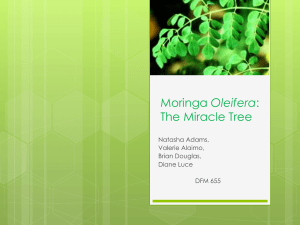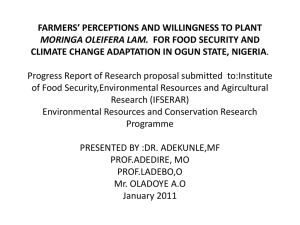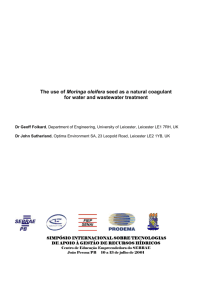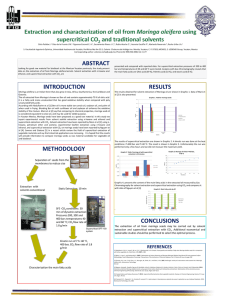Synthetic lead water
advertisement
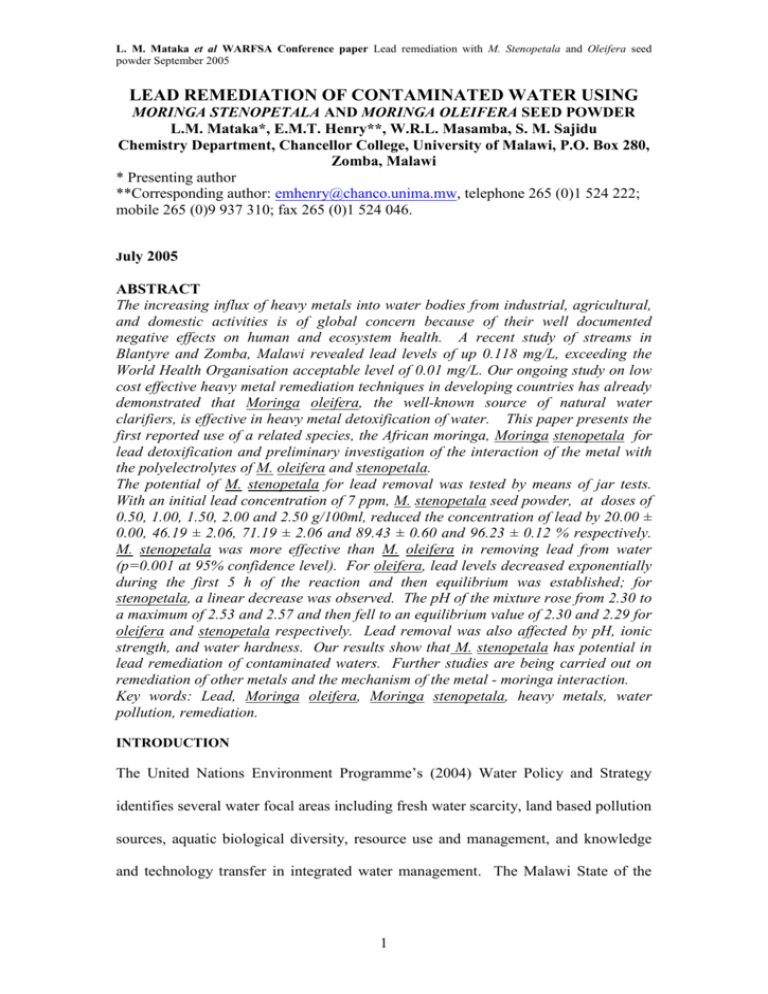
L. M. Mataka et al WARFSA Conference paper Lead remediation with M. Stenopetala and Oleifera seed powder September 2005 LEAD REMEDIATION OF CONTAMINATED WATER USING MORINGA STENOPETALA AND MORINGA OLEIFERA SEED POWDER L.M. Mataka*, E.M.T. Henry**, W.R.L. Masamba, S. M. Sajidu Chemistry Department, Chancellor College, University of Malawi, P.O. Box 280, Zomba, Malawi * Presenting author **Corresponding author: emhenry@chanco.unima.mw, telephone 265 (0)1 524 222; mobile 265 (0)9 937 310; fax 265 (0)1 524 046. July 2005 ABSTRACT The increasing influx of heavy metals into water bodies from industrial, agricultural, and domestic activities is of global concern because of their well documented negative effects on human and ecosystem health. A recent study of streams in Blantyre and Zomba, Malawi revealed lead levels of up 0.118 mg/L, exceeding the World Health Organisation acceptable level of 0.01 mg/L. Our ongoing study on low cost effective heavy metal remediation techniques in developing countries has already demonstrated that Moringa oleifera, the well-known source of natural water clarifiers, is effective in heavy metal detoxification of water. This paper presents the first reported use of a related species, the African moringa, Moringa stenopetala for lead detoxification and preliminary investigation of the interaction of the metal with the polyelectrolytes of M. oleifera and stenopetala. The potential of M. stenopetala for lead removal was tested by means of jar tests. With an initial lead concentration of 7 ppm, M. stenopetala seed powder, at doses of 0.50, 1.00, 1.50, 2.00 and 2.50 g/100ml, reduced the concentration of lead by 20.00 ± 0.00, 46.19 ± 2.06, 71.19 ± 2.06 and 89.43 ± 0.60 and 96.23 ± 0.12 % respectively. M. stenopetala was more effective than M. oleifera in removing lead from water (p=0.001 at 95% confidence level). For oleifera, lead levels decreased exponentially during the first 5 h of the reaction and then equilibrium was established; for stenopetala, a linear decrease was observed. The pH of the mixture rose from 2.30 to a maximum of 2.53 and 2.57 and then fell to an equilibrium value of 2.30 and 2.29 for oleifera and stenopetala respectively. Lead removal was also affected by pH, ionic strength, and water hardness. Our results show that M. stenopetala has potential in lead remediation of contaminated waters. Further studies are being carried out on remediation of other metals and the mechanism of the metal - moringa interaction. Key words: Lead, Moringa oleifera, Moringa stenopetala, heavy metals, water pollution, remediation. INTRODUCTION The United Nations Environment Programme’s (2004) Water Policy and Strategy identifies several water focal areas including fresh water scarcity, land based pollution sources, aquatic biological diversity, resource use and management, and knowledge and technology transfer in integrated water management. The Malawi State of the 1 L. M. Mataka et al WARFSA Conference paper Lead remediation with M. Stenopetala and Oleifera seed powder September 2005 Environment Report notes that water degradation is a major environmental problem that threatens the health and well being of humans and ecosystems (Malawi Government, 2002). Improper disposal of various types of waste, deforestation, and poor agricultural practices that encourage soil erosion and deposition of sediments into the water bodies were identified as the major causes of water degradation in Malawi. Studies of Malawian urban water bodies and wastewater treatment plants revealed that some water quality parameters including heavy metals exceed the World Health Organization (WHO, 2004) acceptable limits (Matope, 2002, Banda et al., 2001, Sajidu et al., 2005). Of particular concern are the high levels of lead in some of the water bodies. The Sanitation Master Plan for the City of Blantyre (Matope, 2002) reported lead levels of 0.73-0.96 mg/L in Mudi and Limbe streams and Banda et al. (2001) recorded 0.23 ± 0.00 mg/L lead for the Lunyangwa river basin, all above the WHO acceptable limits of less than 0.01mg/L. Our recent quality inventory compilation of Blantyre streams (Limbe, Nasolo, and Mudi) and wastewater treatment plants (Limbe and Soche) recorded levels of lead from 0.027 to 0.118 mg/L with most values exceeding the WHO limit (Sajidu et al., 2005). Lead is a pollutant of global concern with well known toxic effects. (Alloway and Ayres,1990). Major sources of lead pollution in water are lead-acid batteries, lead pipes, solders, agricultural chemicals, lead mining, and vehicle exhausts especially where, as in Malawi, leaded petrol has not been completely phased out. Lead is a powerful neurotoxin and a range of pathological conditions is associated with acute lead poisoning, the most characteristic being cerebral oedema. Clean-up technologies for the removal of lead and other heavy metals from water include chemical coagulation using aluminium and ferric salts (Fatoki and Ogunfowokan, 2002) and 2 L. M. Mataka et al WARFSA Conference paper Lead remediation with M. Stenopetala and Oleifera seed powder September 2005 cationic surfactants (Evans, 2003); physical precipitation using ion exchange and sorbents (Singh et al, 2001); and phytoremediation that includes rhizofiltration, phytostabilisation, phytoextraction (Lyte et al, 1998, Lambert et al., 2003). However, water and wastewater treatment in Malawi does not involve heavy metal removal or monitoring due to the high costs and/or the lack of technical expertise. Recently there has been increased interest in the subject of natural coagulants for treatment of water and wastewater in developing countries (Jahn, 1986; Ndabingesere et al, 1995; Sutherland et al, 1994; Gebremichael, 2004; Henry et al., 2004). The tropical plants of the family of Moringaceae, are amongst some of the natural coagulants that have been studied for clarification of turbid water. Moringa oleifera is the most widely distributed, well-known and studied species of the family Moringaceae because of its previous economic importance as a source of the commercially important ‘Ben oil’ and more recently, as a multipurpose tree for arid lands and a source of water purifying agents for developing countries (Morton, 1991). M. oleifera is native to sub-Himalayan North-western India and Pakistan but the plant was distributed to other areas of tropical Asia in prehistoric times and to other parts of the world including Malawi during the British colonial era. M. stenopetala, often referred to as the African Moringa Tree, originates from southern Ethiopia and Kenya (Jahn, 1991). The food, fodder, water clarifying and medicinal uses of the Moringaceae, especially oleifera are well documented and the trees are recommended for live fencing, intercropping, and pollution control (Morton, 1991; Moges, 2004; Coote et al. 1997; Pratt et al. 2002; Williamson, 1975, Palgrave, 1983; van Wyk and van Wyk, 1997). The water soluble Moringa seed proteins possess coagulating properties similar to those of alum and synthetic cationic polymers. Jahn (1981) first 3 L. M. Mataka et al WARFSA Conference paper Lead remediation with M. Stenopetala and Oleifera seed powder September 2005 studied and confirmed the coagulating properties of Moringa seeds after observing women in Sudan use the seeds to clarify the turbid Nile waters. The active agents in Moringa extracts responsible for coagulation are dimeric cationic proteins with molecular weight of 13,000 Da and isoelectric points between 10 and 11 (Jahn, 1981; Ndabigengesere et al., 1995). The mechanism of coagulation was suggested to be adsorption and neutralisation of charges, or adsorption and bridging of destabilised particles, the two assumed to take place simultaneously. Gassenschmidt et al. (1995) reported the isolation from M. oleifera of a flocculating protein of 60 residues with molecular mass of about 6.5 kDa, isoelectronic point above pH 10, high levels of glutamine, arginine and proline with the amino terminus blocked by pyroglutamate, and flocculant capacity comparable to a synthetic polyacrylamide cationic polymer. However, a non-protein coagulant has also been reported but not characterised (Okuda et al, 2001). Our earlier studies showed that M. oleifera seed powder is effective in heavy metal remediation of water (Sajidu et al, 2005). The African moringa, M. stenopetala is a quick growing tree 6-10m tall with a trunk 60 cm in diameter at breast height, strongly branched, thick at base with a bark white to pale grey or silvery, smooth wood and soft leaves up to 55 cm long (Jahn, 1991, Moges, 2004).. The species is known by different vernacular names such as Kallanki and Haleko (Ethiopia), and Cabbage Tree (English). M. stenopetala is less widely distributed than M. oleifera but stenopetala is reportedly more resistant to insect pests than other members of the family and its seeds are larger and easier to process than those of oleifera (Kayambazinthu, D., Forestry Research Institute of Malawi, personal communication, 2003). 4 L. M. Mataka et al WARFSA Conference paper Lead remediation with M. Stenopetala and Oleifera seed powder September 2005 Although the water clarifying properties of M. stenopetala have not been as extensively studied as those of M. oleifera, Jahn (1986) reported that 100-150 mg/L of M. stenopetala was as effective in water clarification as 200 mg/L of M. oleifera which indicates that stenopetala is more effective than oleifera. However, no work has been reported previously on the potential of M. stenopetala to remove heavy metals from water. The objectives of this study, therefore, were to evaluate the potential of M. stenopetala in removing lead from water and compare its effectiveness with that of M. oleifera reported earlier by our group (Sajidu et al., 2005) and therefore this is the first report on the potential of Moringa stenopetala on heavy metal removal. MATERIALS AND METHODS Materials Seeds were identified by the Forestry Research Institute of Malawi. Moringa stenopetala seeds were obtained from Kenya (Whizpop Products Ltd., Nairobi). Moringa oleifera seeds were collected from Chikwawa district in southern Malawi. Seeds were deshelled by hand and the deshelled seeds were ground in a coffee mill (National MX-J210PN), until a consistent powder was obtained. Defatted cakes were prepared by cold solvent extraction of the powdered seed with hexane fraction and traces of fat were removed from the residue by washing with diethyl ether until the residue was confirmed as fat free using a paper test and then dried in a vacuum oven (Gallenkamp OVL 570 010 J) at 40˚C and 600 mbars for 24-48h. The following analytical grade chemicals were used: lead nitrate (BDH Chemicals Limited, Poole, UK); sodium carbonate, magnesium sulphate, sodium bicarbonate, hexane fraction (Sarchem (Pty) Krugersdorp Ltd, RSA); sodium chloride, sodium hydroxide, calcium 5 L. M. Mataka et al WARFSA Conference paper Lead remediation with M. Stenopetala and Oleifera seed powder September 2005 chloride and nitric acid (Associated Chemical Enterprises (Pty) Ltd, RSA); hydrochloric acid, diethyl ether (Glassworld, RSA). pH was determined using a pH meter (Metrohm 744) checked with buffers at pH 4 and 7; constant temperature treatments were done in a constant temperature water bath (Bath: Haake Type 0005584, Thermostirrer: Gallenkamp No. 85) and shaking was done using a Griffin shaker. Microsoft Excel was used for descriptive statistics kinetic data plots. Analyses of variance were carried out using GenStat Discovery Edition. Treatment data was plotted using SigmaPlot 8.0. Methods Synthetic lead water Synthetic lead water was obtained by dilution of a stock lead solution (1000 ppm) prepared by dissolving lead nitrate in de-ionised water or sodium chloride solution as described by the American Public Health Association (APHA, 1990). Determination of lead content Lead concentration was determined using atomic absorption spectroscopy (Shimadzu AA-680G V-5) at 283.3 nm with an air-acetylene flame as described by APHA (1990). Lead removal 100 ml of synthetic lead water containing 7 ppm Pb was prepared using deionised water and appropriate masses of whole seed or defatted powder were added and the mixture stirred for 1 h. The mixture was filtered by gravity through Whatman No.1 filter paper and the lead concentration of the filtrate was determined. Kinetics of lead removal 6 L. M. Mataka et al WARFSA Conference paper Lead remediation with M. Stenopetala and Oleifera seed powder September 2005 Synthetic lead water containing 7 ppm Pb was treated with 1.0 g of Moringa oleifera and 0.5 g of Moringa stenopetala whole seed cake and the residual Pb concentration of the solution quantified after different times of treatment. Temperature dependence 7 ppm synthetic lead water was treated with 1.0 g M. oleifera or stenopetala at different temperatures. The moringa suspension was immersed in a constant temperature water bath with shaking for 1 h and the residual lead concentration quantified. pH changes during treatment 2.5 g portions of M. stenopetala or oleifera were added to 100 ml of 7 ppm or 3 ppm Pb in deionised water or 0.1 M sodium chloride and the pH recorded at intervals. Effect of pH on lead removal capacity Synthetic lead water of different pH’s were prepared by adjusting the pH of a solution of 7 ppm Pb in deionised water using 1M sodium hydroxide or hydrochloric acid and the resulting lead solutions treated with Moringa whole seed cakes for 1 h. Effect of water hardness 7 ppm Pb solutions were treated with 1.5 g of Moringa whole seed powders suspended in different concentrations of Mg2+/Ca2+ or HCO3-/CO32- mixtures. The Mg2+/Ca2+ was prepared as described in Texas specification No. 485-54-09A. The HCO3-/CO32 mixture was prepared by dissolving 1.3768g NaHCO3, and 1.7662g Na2CO3 to make a 1000 ppm mixture and this was diluted to different appropriate concentrations. Effect of sodium chloride Solutions containing 7 ppm Pb in 0.0, 0.2, 0.4, 0.6, and 0.8 M sodium chloride were prepared by combining and diluting the stock lead solution (1000 ppm) and a 1 M 7 L. M. Mataka et al WARFSA Conference paper Lead remediation with M. Stenopetala and Oleifera seed powder September 2005 stock solution of sodium chloride. The solutions were treated with 1.5 g of M. oleifera or stenopetala whole seed cake and the residual lead concentration determined. RESULTS AND DISCUSSION Lead ion removal The results indicate that M. stenopetala has the capacity to remove heavy metals from water (Table 1) and the effectiveness of removal increases with increasing dosage of whole seed powder with p <0.001 at 95% CL. There was no significant difference for lead removal at 1 h and 24 h (p = 0.348) and 1 h treatment is recommended for lead removal using Moringa stenopetala whole seed cake. Table 1: Metal ion removal by M. stenopetala whole seed cake at initial metal ion concentration of 7 ppm at around 25˚C Dosage (g/100ml) 0.5 1.0 1.5 2.0 Remaining lead conc./ppm Remaining lead conc./ppm after 1 h (% removal) after 24 h (% removal) 5.60± 0.00 5.03± 0.25 (20.00± 0.00) (28.14± 3.57) 3.77± 0.14 3.28± 0.00 (46.19± 2.06) (53.14± 0.00) 2.02± 0.14 2.03± 0.00 (71.19± 2.06) (71.00±0.00) 0.74± 0.04 0.99 ± 0.004 (89.43 ± 0.60) (85.85 ± 0.51) 8 L. M. Mataka et al WARFSA Conference paper Lead remediation with M. Stenopetala and Oleifera seed powder September 2005 2.5 0.26 ± 0.01 0.71 ± 0.03 (96.23 ± 0.12) (89.83 ± 0.46) Similar results were obtained using defatted cakes (Table 2). Metal ion removal increased with increasing dosage of M. stenopetala defatted seed cake (p <0.001) and there was no significant difference for Pb removal at 1 h and 24 h (p=0.55). Comparison of the effectiveness of Pb removal of the defatted cakes (Table 2) and the whole seed powder (Table 1) showed that the defatted cakes were more effective than the whole seed cakes (p <0.001) probably because lipids were not involved in the metal ion removal process and thus defatting, by removing the lipids, increased the relative concentration of the polyelectrolytes, the likely agents of metal ion removal. Table 2: Metal ion removal by hexane defatted M. stenopetala at initial metal ion concentration of 7 ppm around 25˚C Dosage Remaining lead conc./ppm Remaining lead conc./ppm (g/100ml) after 1 h (% removal) after 24 h (% removal) 0.5 4.43±0.27 4.35± 0.00 (36.76± 3.79) (38.00 0.00) 1.64 0.13 1.87± 0.13 (76.71± 1.98) (73.33± 1.88) 1.5 Not detected Not detected 2.5 Not detected Not detected 1.0 9 L. M. Mataka et al WARFSA Conference paper Lead remediation with M. Stenopetala and Oleifera seed powder September 2005 Comparison of the removal effectiveness of Moringa oleifera and Moringa stenopetala (Table 3) using ANOVA showed that there was a significant difference in the effectiveness of removal with stenopetala being more effective than oleifera (p = 0.001). These results agree with Jahn’s (1986) observation that stenopetala is a better water clarifier than oleifera and suggest that the same agents, the polyelectrolytes, are responsible for water clarification and lead removal. Table 3: Comparison of 1 h treatment of lead water using whole seed powders M. oleifera and M. stenopetala Dosage Remaining lead conc./ppm Remaining lead conc./ppm (g/100ml) MOWSK (% removal) MSWSK (% removal) 1.0 3.66± 0.00 3.36± 0.17 (47.71± 0.00) (52.05± 2.40) 2.21± 0.00 1.91± 0.064 (68.43± 0.00) (72.52± 0.91) 1.5 Kinetics of lead removal Time dependence studies of lead removal by stenopetala gave a straight line plot for lead concentration versus time suggesting that removal is zero order with respect to metal ion (Figure 1). For oleifera, a plot of natural log of lead concentration .versus time gave a straight line indicating that removal is either first order or pseudo first order (Figure 2). . lnPb vs time MO WSK Remaining concentration vs time using MS wsk 6.50 6.00 lnPb conc./ppm R2 = 0.883 5.50 5.00 4.50 0.00 10 2.00 4.00 6.00 time/hr 8.00 10.00 2 R = 0.8084 1.60 1.40 1.20 1.00 0.80 0.60 0.40 0.20 0.00 0 5 10 15 time/hr 20 25 30 L. M. Mataka et al WARFSA Conference paper Lead remediation with M. Stenopetala and Oleifera seed powder September 2005 Figure 1 Relationship between concentration and time for M. stenopetala whole seed cake and Figure 2 Relationship between concentration and time for M. oleifera whole seed cake Effects of other ions on metal removal (a) Sodium chloride Figure 3 shows the effect of increasing NaCl ionic strength on lead removal using Moringa. Metal ion removal decreased with an increase in the concentration of NaCl from 0.0 to 0.8 M. The percentage decreased from 72.00 to 16.44 % for oleifera and from 65.76 to 34.84 % for stenopetala. The observed decrease in percentage metal ion removal with increase in salt concentration is expected when the mechanism involves electrostatic interaction. At high ionic strength the sodium ions can compete for interacting sites with Pb2+ ions on the polyelectrolytes hence reducing lead removal. Furthermore Pb2+ forms stable complexes with chloride ions which inhibits interaction between Pb2+ and the polyelectrolyte site (http://www.iontosorb.cz; Krishnan and Aniruda, 2003) 80 70 MO treatment MS treatment % removal 60 50 40 30 20 10 0.0 0.2 0.4 0.6 NaCl Conc./M 11 0.8 1.0 L. M. Mataka et al WARFSA Conference paper Lead remediation with M. Stenopetala and Oleifera seed powder September 2005 Figure 3 Relationship between NaCl concentration and lead ion removal using Moringa whole seed cakes at initial lead ion concentration of 7ppm Water hardness ions (Mg2+/Ca2+ and HCO3-/CO32-) (b) Figure 4 shows the effects of magnesium/calcium mixture and carbonates/bicarbonates mixture on lead ion removal using the Moringa whole seed cakes. Generally the results showed that carbonates/bicarbonates concentration enhances lead ion removal. This is likely due to the formation of low solubility lead carbonates which precipitates out of the solution (McGinnes, 2002). For the Mg/Ca concentration there is no general trend however more work is being carried out to further investigate on their effects. 120 MS carbonates/bicarbonates MS magnesium/calcium MO carbonates/bicarbonates MO magnesium/calcium 110 % removal 100 90 80 70 60 0 100 200 300 400 500 Concentration of other ions/ppm Figure 4 Effects of water hardness on lead ion removal using oleifera and stenopetala whole seed cake at 7ppm lead concentration and 25oC pH changes 12 L. M. Mataka et al WARFSA Conference paper Lead remediation with M. Stenopetala and Oleifera seed powder September 2005 (a) pH changes in during treatment Figure 5 compares the change in pH with time for 7 and 3 ppm lead in deionised water and in 0.1M sodium chloride solution. The variation in pH is more pronounced for 3 ppm Pb2+ solution in deionised water and least pronounced in 0.1 M NaCl solution. oleifera deionised water stenopetala deionised water oleifera 0.1M NaCl stenopetala 0.1MNaCl oleifera 3ppm deionised water stenopetala 3ppm deionised water 8 pH 6 4 2 0 0 100 200 300 400 500 Time/min Figure 5 Change in pH with treatment time for lead ion removal using 2.5g M. stenopetala and oleifera in de-ionised water and 0.1M NaCl solution initial lead concentration of 7 and 3ppm (23.5˚C) It was assumed that at maximum pH there was higher concentration of free Moringa polyelectrolytes in the solution. Therefore at low (3 ppm) Pb2+ concentration the highest concentration of free polyelectrolytes is expected due to less interacting sites. At 7 ppm more interaction is expected due to a greater amount of Pb2+ hence lower maximum pH. The lowest maximum pH was for the treatment in NaCl solution and is 13 L. M. Mataka et al WARFSA Conference paper Lead remediation with M. Stenopetala and Oleifera seed powder September 2005 likely due to the greater amounts of ions present which have a salting out effect on proteins and inhibit the extraction and dissolution of the free polyelectrolytes. (b) Effect of initial pH Figure 7 shows the percentage Pb versus pH for a pH range of 2.0 to 10.0. The percentage removal increased with an increase in pH. The maximum removals, 93.99 % and 98.39 %, are observed at pH 10 indicating that Moringa is more effective in Pb2+ removal at higher pH. This could be due to the formation of insoluble lead hydroxides at higher pH. The decrease in efficiency of lead removal with decrease in pH could also be attributed to the presence of H+ ions in the mixture which compete with Pb2+ ions for the interaction sites (Krishnan and Aniruda, 2003; Raji et al, 1997). 100 % removal 80 Moringa stenopetala Moringa oleifera 60 40 20 2 4 6 8 10 12 pH Figure 7 Relationship between pH and % removal using Moringa whole seed cakes at initial lead ion concentration of 7ppm and 25oC Effect of temperature on lead removal 14 L. M. Mataka et al WARFSA Conference paper Lead remediation with M. Stenopetala and Oleifera seed powder September 2005 The percentage removal of lead ions increased with temperature (Figure 8) possibly due to the breakdown of the protein chain at higher temperatures to expose more sites for interaction with metal ions. 65 60 % removal 55 50 Moringa stenopetala Moringa oleifera 45 40 35 30 0 20 40 60 80 100 120 Temp./degrees Figure 8 Dependence of metal removal on temperature CONCLUSION The study has shown that Moringa stenopetala seed powder can be used as an effective heavy metal purifier in water and that Moringa stenopetala is more effective than oleifera in heavy metal removal. ACKNOWLEDGEMENT The authors acknowledge the material support of the International Programme in Chemical Sciences (IPICS) through the University of Uppsala, Sweden and the technical advice of the Forestry Institute of Malawi, Zomba. REFERENCES 15 L. M. Mataka et al WARFSA Conference paper Lead remediation with M. Stenopetala and Oleifera seed powder September 2005 Alloway, B. J. and Ayres, D. C. (1990). Chemical principles of environmental pollution. Chapman Hall: London. APHA. (1990). Standard methods for the examination of wastewater, 17th edition. Washington DC. Banda, L., Fabiano, E and Saka, J. D. K (2001). Effects of human activities on water quality in Lunyangwa River basin, Mzuzu, Malawi. Proceedings of the First Chancellor College Research Dissemination Conference. 28-30 March 2001. University of Malawi. Zomba. pp 274-275 Coote, C., Bonongwe, C., and Stewart, M. (1997). The distribution, uses and potential of development of Moringa oleifera in Malawi. Forestry Research Record No.67. Forest Research Institute of Malawi, Zomba Evans, C. V. (2003). Removal of heavy metals and radionuclides from soils using cationic surfactant flushing. University of Wisconsin Water Resources Institute Fatoki O.S., Ogunfowokan A.O. (2002). Effect of coagulant treatment on the metal composition of raw water. Water SA 28 (3) Gassenschmidt U., Jany, D. K., Tauscher, N. H., (1994). Isolation and characterisation of a flocculating protein from Moringa oleifera Lam. Biochemica et Biophysica Acta 1243 (1995) 477-481 Ghebremichael, K. A., (2004). Moringa seed and pumice as alternative natural materials for drinking water treatment. PhD Thesis. University of Stolkholm, Sweden. Henry E., Dembo E.G., Sajidu S.M. and Zimba G. (2005). A Preliminary Investigation on use of Moringa oleifera polyelectrolytes for wastewater treatment in Malawi. pp283 – 291. In: K. Mathew, I. Nhapi (Eds). Water 16 L. M. Mataka et al WARFSA Conference paper Lead remediation with M. Stenopetala and Oleifera seed powder September 2005 & wastewater management for developing countries (WAMDEC 2004). IWA Water and Environment Management Series ISB #1-84339-511-8 Proceedings of the Water & Wastewater Management for Developing Countries Conference, Victoria Falls, 28- 30 July, 2004 Jahn, S. A., (1981). Tradition water purification in tropical and developing countries Existing methods and potential application. Publ 117. Deutsche Gesellschaft fur Technische Zusammenarbeit (GTZ) GmbH, Eschborn Jahn, S. A., (1986). Proper use of African natural coagulants for rural water supplies: Research in the Sudan and a guide for new projects. Deutsche Gesellschaft fur Technische Zusammenarbeit (GTZ) GmbH, Eschborn. Jahn, S. A., (1991). The Traditional Domestication of a multipurpose tree Moringa stenopetala (Bak. f.) Cuf. In the Ethiopian Rift Valley. Ambio 20: 244-247 Krishnan, K. A., and Aniruda, T. S. (2003). Removal of cadmium(II) from aqueous solutions by steam-activated sulphurised carbon prepared from sugar-cane bagasse pith: Kinetics and equilibrium studies. Water SA 29: 147-156. Lambert, M. Leven, B. Green, R. (2003). New methods of cleaning up heavy metal in soils and water innovative solutions to an environmental problem http://www.envirotools.org/ 17/07/05 Lyte, C. M., Lytle, W. F., Yang, N., Quian, J., Hansen, B., Zayed, A. and Terry, N. (1998). Reduction of Cr(IV) to Cr(III) by wetland plants: Potential for situ heavy metal detoxification, Environ. Sci. Technol 32: 3087-3093 Malawi Government (2002). State of Environmental Report for Malawi 2002. Ministry of Natural resources and Environmental Affairs, Lilongwe Malawi. 17 L. M. Mataka et al WARFSA Conference paper Lead remediation with M. Stenopetala and Oleifera seed powder September 2005 Matope J. (2002). Blantyre City Environment Profile Report, United Nations Development Programme: Geneva. McGinnes, M. (2002). Wastewater from a Lead-Acid battery washing operation. Ecoshield Environmental Systems, Inc. www.nmfrc.org 30/08/05 Moges, Y. (2004). Recommended agroforestry/multipurpose trees for Borana lowlands/midlands and their production techniques. Subreport No.4: FARM Africa/SOS Sahel, Tropical forestry. Morton, J.F. (1991). The Horseradish tree, Moringa Pterygosperma (Moringacae) – A Boon to Arid Lands. Economic Botany 45: 318-333. Ndabigengesere, A., Narasiah, K.S., Talbot, G. B. (1995). Active agents and mechanism of coagulation of turbid waters using Moringa oleifera. Water Res., 29: 703-710 Okuda T., Baes A.U. Nishijima W. and Okada M. (2001). Coagulation mechanism of salt solution extracted active component in Moringa oleifera seed. Water Res., 35(3): 830-834 Palgrave, K. C. (1983). Trees of southern Africa. Struik Publishers (Pty), Capetown. Raji, C., Manju G. N.,and Anirudhan, T. S., (1997). Removal of heavy metal ions from water using sawdust-based activated carbon. Indian J. Eng. Mater. Sci. 4 228-236 Sajidu, S. M. I., Henry E.M.T., Kwamdera, G and Mataka, L. (2005). Removal of lead, iron and cadmium by means of polyelectrolytes from Moringa oleifera whole seed kernel: Water Resource Management III 251 Singh S.P., Ma, L.Q. and Harris W.G. (2001). Heavy metal interactions with phosphatic clay: sorption and desorption behaviour. J. Environ. Qual., 30: 1961-1968. 18 L. M. Mataka et al WARFSA Conference paper Lead remediation with M. Stenopetala and Oleifera seed powder September 2005 Sorption of cadmium and lead by chelating ion exchangers http://www.iontosorb.cz/cd-pb.htm. 16/09/05 Sutherland, J. P., Folkard, G. K., Mtawali, M. A., and Grant, W. D. (1994), Moringa oleifera as a natural coagulant. 20th Water Engineering and Development Centre (WEDC) Conference held in Colombo, Sri Lanka. Texas Specification No. 485-54-09A. (1996). Specification for floor finish remover concentrate http://www.tbpc.state.tx.us. 15/08/05 UNEP. (2004). Water Policy and Strategy. United Nations Environment Programme http:/www.unep.org. 14/09/05 Van Wyk, B. and Van Wyk, P. (1998). Field guide to trees of southern Africa Struik Publishers (Pty), Capetown 8001 Williamson, J. (1975). Useful plants of Malawi. University of Malawi. Zomba World Health Organisation (WHO) 2004. Guidelines for drinking water quality Vol 1. Recommendations, WHO: Geneva. 19
